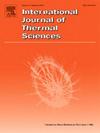Analysis of full-scale thermal-hydraulic characteristics of sodium-cooled fast reactor core under steady-state and accident scenarios
IF 4.9
2区 工程技术
Q1 ENGINEERING, MECHANICAL
International Journal of Thermal Sciences
Pub Date : 2025-04-08
DOI:10.1016/j.ijthermalsci.2025.109909
引用次数: 0
Abstract
Based on the open-source CFD platform OpenFOAM, CorTAF-SFR has been developed to analyze the 3D thermal-hydraulic characteristics of sodium-cooled fast reactor (SFR) fuel rod assemblies using the finite volume method. The code has been validated against the ORNL-FFM2A and SCARLET-II experiments, demonstrating its accuracy in predicting the thermal-hydraulic behavior of fuel rod assemblies under both steady-state and blockage conditions. The tool was further applied to analyze the thermal-hydraulic performance of the China Experimental Fast Reactor (CEFR) under steady-state operation and accident scenarios. Under steady-state conditions, the average coolant outlet temperature deviation from the design values was within 2.0 K, with significant temperature drops observed at the component interface regions. During an overpower accident, peak temperatures of the coolant, cladding surface, and fuel pellet reached 1028.4 K, 1030.6 K, and 1598.9 K, respectively. In the blockage accident, the temperature of the blocked area increased significantly, and the coolant flow rate at about 150 mm downstream of the blocked area returned to the original level. Detailed analysis revealed the thermal-hydraulic behavior changes during the overpower scenario and the mechanisms of flow and temperature field alterations in blocked regions. These findings are crucial for advancing thermal-hydraulic analysis methods for SFR cores and ensuring reactor safety and performance.
稳态和事故工况下钠冷快堆堆芯全尺寸热水力特性分析
基于开源CFD平台OpenFOAM,采用有限体积法开发了CorTAF-SFR,用于分析钠冷快堆燃料棒组件的三维热工特性。通过ORNL-FFM2A和SCARLET-II实验验证了该程序在预测稳态和堵塞条件下燃料棒组件热工性能方面的准确性。应用该工具进一步分析了中国实验快堆(CEFR)在稳态运行和事故情景下的热工性能。在稳态条件下,冷却液出口温度与设计值的平均偏差在2.0 K以内,组件界面区域温度明显下降。在过热事故中,冷却剂、包层表面和燃料球团的峰值温度分别达到1028.4 K、1030.6 K和1598.9 K。在堵塞事故中,堵塞区域温度明显升高,堵塞区域下游约150mm处的冷却剂流量恢复到原始水平。详细分析了高压情景下的热液行为变化,以及阻塞区流场和温度场变化的机理。这些发现对于推进SFR堆芯热水力分析方法,确保反应堆安全和性能具有重要意义。
本文章由计算机程序翻译,如有差异,请以英文原文为准。
求助全文
约1分钟内获得全文
求助全文
来源期刊

International Journal of Thermal Sciences
工程技术-工程:机械
CiteScore
8.10
自引率
11.10%
发文量
531
审稿时长
55 days
期刊介绍:
The International Journal of Thermal Sciences is a journal devoted to the publication of fundamental studies on the physics of transfer processes in general, with an emphasis on thermal aspects and also applied research on various processes, energy systems and the environment. Articles are published in English and French, and are subject to peer review.
The fundamental subjects considered within the scope of the journal are:
* Heat and relevant mass transfer at all scales (nano, micro and macro) and in all types of material (heterogeneous, composites, biological,...) and fluid flow
* Forced, natural or mixed convection in reactive or non-reactive media
* Single or multi–phase fluid flow with or without phase change
* Near–and far–field radiative heat transfer
* Combined modes of heat transfer in complex systems (for example, plasmas, biological, geological,...)
* Multiscale modelling
The applied research topics include:
* Heat exchangers, heat pipes, cooling processes
* Transport phenomena taking place in industrial processes (chemical, food and agricultural, metallurgical, space and aeronautical, automobile industries)
* Nano–and micro–technology for energy, space, biosystems and devices
* Heat transport analysis in advanced systems
* Impact of energy–related processes on environment, and emerging energy systems
The study of thermophysical properties of materials and fluids, thermal measurement techniques, inverse methods, and the developments of experimental methods are within the scope of the International Journal of Thermal Sciences which also covers the modelling, and numerical methods applied to thermal transfer.
 求助内容:
求助内容: 应助结果提醒方式:
应助结果提醒方式:


